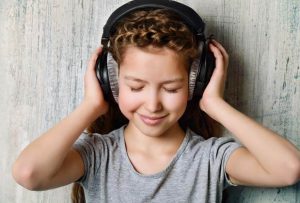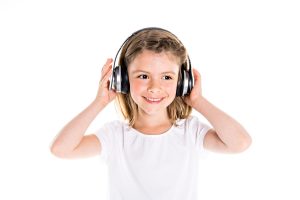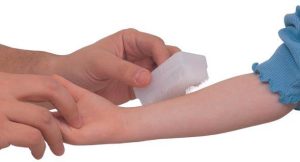Specialized Programs
Pediatric Potentials, Inc. frequently uses highly specialized programs to complement our therapy services.
Therapeutic Listening®
 Therapeutic Listening® is an auditory integration training program that was developed by Occupational Therapists, Sheila Frick and Colleen Hacker, more than 20 years ago. It is a treatment tool that was created to be used as an intensive home-based therapy program in addition to sensory therapy provided by a trained professional. This program uses sound stimulation with altered headphones and modified music to stimulate different parts of the brain, to help speed up developmental gains and success with learning.
Therapeutic Listening® is an auditory integration training program that was developed by Occupational Therapists, Sheila Frick and Colleen Hacker, more than 20 years ago. It is a treatment tool that was created to be used as an intensive home-based therapy program in addition to sensory therapy provided by a trained professional. This program uses sound stimulation with altered headphones and modified music to stimulate different parts of the brain, to help speed up developmental gains and success with learning.
Therapeutic Listening® makes use of varied types of sound that range in musical style, including electronic sounding music, upbeat songs, drum sounds, jungle music, nature sounds, favorite kid songs, and many classical pieces. All music pieces are altered and enhanced in order to help make therapeutic gains. This program was developed based on some of the same principles and technology originally discovered and designed by Alfred Tomatis, Guy Berard, and Ingo Steinbach.
A therapist trained in Therapeutic Listening® creates intensive home-based listening programs based on each client’s individual needs and goals. This program has helped our clients to make very significant and lasting improvements in their abilities, when completed correctly.
 This program has helped many of our clients improve in the following areas:
This program has helped many of our clients improve in the following areas:
- Sound sensitivity
- Sleep difficulties
- Organizational skills
- Energy levels and engagement with others
- Coordination, rhythm, timing and sequencing
- Handwriting- letter size, line placement, and spacing
- Focus, attention, and ability to follow directions
- Tantrums, overall mood, emotional connection, and the ability to get through the day with less stress
- Language and academic readiness skills- so learning and communication skills are easier, and to help some clients be more ready for Speech Therapy sessions, to target higher level language skills
Our pediatric therapists will let you know after your child’s initial Occupational Therapy evaluation if we feel this program would be beneficial and successful. We complete trials of this program in our OT sessions and recommend it as a home program, once we feel your child will benefit, without any negative responses. Feel free to ask us questions about this program at any time. We love to explain it and share our excitement for it, especially when we feel it will be beneficial for your child!
Handwriting Without Tears®
 Handwriting is a very common challenge that parents often report when they come to us for Occupational Therapy. Many people don’t realize that it takes a lot of other skills to be developed and matured within a child’s body, in order for handwriting to improve to an age-appropriate level. If your child has intentionally tried to improve his or her handwriting and it’s just not enough, then an Occupational Therapy Evaluation may be recommended.
Handwriting is a very common challenge that parents often report when they come to us for Occupational Therapy. Many people don’t realize that it takes a lot of other skills to be developed and matured within a child’s body, in order for handwriting to improve to an age-appropriate level. If your child has intentionally tried to improve his or her handwriting and it’s just not enough, then an Occupational Therapy Evaluation may be recommended.
We are proud to be trained in the Handwriting Without Tears® program and use this as our base for teaching children how to form letters and fix handwriting errors. This program is a very highly regarded program that uses a multisensory approach to teaching and remediating handwriting. This program uses a hands-on approach that engages the children and makes learning to write fun and successful. Handwriting Without Tears® covers Pre-K through 5th grade handwriting, and teaches both print and cursive. It is easily adaptable to all levels of writing and learning abilities and also addresses the physical components needed to be successful with writing, including pencil grip and posture.
Our Occupational Therapists thoroughly evaluate the underlying components that support a children’s handwriting, such as their:
- posture
- attention/focus
- eye muscle coordination skills
- sensory arousal state
- muscle strength & endurance (trunk, shoulder, arm, hand, fingers)
- primitive reflexes & coordination of the two sides of their body
- fine motor grasp (how they hold their pencil)
- fine motor control of their fingers (i.e.- if their pencil marks are really shaky, really light or really dark)
- visual perceptual skills (can the child identify the letters and remember how to form them, in the right direction)
Once we determine the areas above that affect a child’s handwriting, we develop a treatment plan of fun activities that help the child to master all of the skills needed to be successful. Some children already have a diagnosis of Dysgraphia, which is a learning disability affecting handwriting. Psychologists are the professionals that diagnose or rule out this condition as well any other learning disabilities. Occupational Therapists are then the therapists that help these children build their skill sets to make great gains, based on whatever weaknesses have been determined with initial testing. We also train parents on how they can set up fun play activities at home that support the development of good handwriting skills, specific to their child.
The Wilbarger Protocol
 The Wilbarger Protocol is a very specific technique created by Occupational Therapist, Patricia Wilbarger, who is a leader in the Pediatric Occupational Therapy profession. She created and used this protocol successfully to treat sensory defensiveness in babies and children. Sensory defensiveness is defined as hypersensitivity or over-reactivity to two of more types of sensory input. This can include hypersensitivity to touch, taste/foods, smells, loud sounds, visually stimulating environments, and/or the sensation of movement (tipping backwards, swinging, car rides, etc.) to the point of having an adverse reaction, before the action even occurs. This is due to negative emotional memories being stored in the body, causing an excessive emotional response from the child.
The Wilbarger Protocol is a very specific technique created by Occupational Therapist, Patricia Wilbarger, who is a leader in the Pediatric Occupational Therapy profession. She created and used this protocol successfully to treat sensory defensiveness in babies and children. Sensory defensiveness is defined as hypersensitivity or over-reactivity to two of more types of sensory input. This can include hypersensitivity to touch, taste/foods, smells, loud sounds, visually stimulating environments, and/or the sensation of movement (tipping backwards, swinging, car rides, etc.) to the point of having an adverse reaction, before the action even occurs. This is due to negative emotional memories being stored in the body, causing an excessive emotional response from the child.
Our director was trained by Patricia Wilbarger for the correct use of this protocol many years ago. Wilbarger trained therapists are the only therapists that should be using this protocol, because it is most often taught incorrectly and then passed on to other family members, teachers or caregivers incorrectly. We spend an hour at our facility training one family member on this protocol, and then have them demonstrate it correctly back to us before they can purchase a brush and complete it at home. We follow up on the accuracy of the protocol multiple times until each parent or caregiver demonstrates this protocol with proficiency. This is a powerful tool to help calm a child’s nervous system and we take it seriously. Please do not watch a video or read about it and try it at home, as it will not be correct. We are more than happy to help train you and your family on this protocol to help your child. We can also help you figure out why it hasn’t worked in the past, and if it’s not well tolerated, what can be done instead.
Astronaut Training Protocol
The vestibular system, centered in the inner ear, is what gives us our sense of balance. It works with our auditory and visual systems to understand the three-dimensional space that surrounds us wherever we go. When it’s disrupted, it can have a profound effect on a child’s ability to organize sensory input, move, learn and pay attention.
Astronaut Training, is a protocol involving precise input to all the vestibular receptors in the inner ear combined with auditory and visual input that works to integrate the sensory systems simultaneously. It was developed by Mary J. Kawar, MS, OTR, an occupational therapist. It uses rotary input (spinning) to elicit reflexive eye movements (nystagmus), that “warm up” the eyes for subsequent focused visual activities. These activities are fun and appealing to children.
Portions of this program can be taught to parents to be practiced at home daily for maximal gains.
Primitive Reflex Integration

Our specialized Pediatric Occupational Therapists have been trained on how to test and treat primitive reflexes in children of all ages, to help with their overall development and therapy gains. Primitive reflexes are adaptive responses that develop when a child is in utero and integrate over time as the brain matures. These reflexes are needed for survival in the early months of life and then mature and integrate, in order for children to develop higher level skills. Physicians and therapists assess these reflexes to help determine the overall maturity of the central nervous system.
Primitive reflexes can still be present in infants/toddlers after: a Cesarean section, trauma, or exposure to toxins, anesthetics, or medications. Other possible causes include: decreased tummy time in infancy, a short period or lack of crawling, walking early, chronic ear infections, or head injuries.
Research shows that reflex integration exercises can help a child improve their sensory responses, motor planning, postural responses and cognitive skills. We provide testing of relevant reflexes in your child’s initial occupational therapy evaluation. We will work on these exercises casually during play-based activities, or teach them as specific exercises to complete at home, when the child is able. Frequent repetition of these exercises is the key to integrating them!
